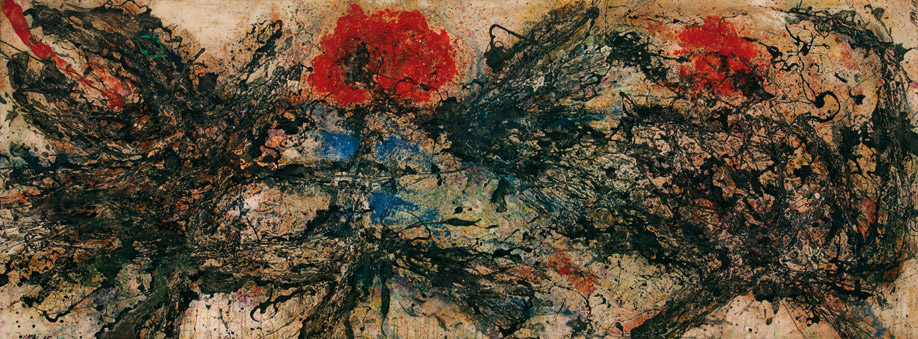According to the note by the artist, the work can be displayed vertical or horizental.
|
Floraison
|
|
1965 Oil on panel 91 x 242.5 cm Signed lower left IMAI in English and dated 65 |
|
Estimate
1,800,000 - 2,800,000 439,000 - 683,000 57,400 - 89,300
|
|
|
Toshimitsu Imai grew up in the family of a port merchant in Osaka. After finishing school in 1948, he was trained at the Tokyo State Art Academy. Imai's early style of painting is reminiscent of the Fauves. He moved to Paris in 1952 where he immediately joined the avant-garde art movement called Art Informel, finding his own cultural background in the Western society.
In 1955, through the French art critic Michel Tapié (1909–1987), Imai built a relationship with artists such as Jean Dubuffet and Jean Fautrier, who were leading members of Art Informel. Under the sway of new impressions and influence, Imai's style underwent a dramatic change. His paintings in the late 1950s were aggressively and intensely textured, with vivid colors of red, yellow and black, and a fierce sense of vibration over the entire pictorial surface. However, the grounds of the paintings had the serenely beautiful texture of Chinese porcelain. This East Asian sensibility confirmed Imai's importance for the Art Informel artists, who were searching for an alternative aesthetic to that of Western modernity. His flamboyant gestural paintings of the 1960s were mainly red, with thickly applied paint and dripping lines running in spiral and radial directions. The present lot "Floraison" is a typical style of Imai's work in that period. The red and black colors are set against a natural background, the splattered paint gives the painting a sense of movement and energy.
Imai played a paramount role in introducing the Art Informel movement in his home country after visiting Japan in 1957 with Tapié, Sam Francis and Georges Mathieu. It literally created a furor over Japanese art constitution. He also made meaningful interaction between members of the Art Informel group and the Gutai Art Association. Apart from his artistic expressions on canvases, he has made a great contribution to the Japanese society.
The success Imai had with his work at the 1953 São Paulo Biennale and the 1960 Venice Biennale brought him international acclaim, followed by recognition at home in 1962. Imai was awarded a prize at the 5th Exhibition of Japanese Contemporary Art in Tokyo and the Museum of Modern Art in Tokyo acquired several of his paintings. Toshimitsu Imai was awarded numerous distinctions in France and elsewhere in Europe. In 1991, he was made an honorary citizen of Madrid, in 1992 of Lyon. In 1996 he was made a chevalier de la Légion d'honneur and in 1997 an Officier de l'Ordre des Arts et des Lettres.
